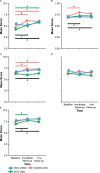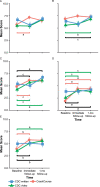Evaluating the Effect of Concussion-Education Programs on Intent to Report Concussion in High School Football
- PMID: 33428746
- PMCID: PMC8582631
- DOI: 10.4085/509-20
Evaluating the Effect of Concussion-Education Programs on Intent to Report Concussion in High School Football
Abstract
Context: Concussion underreporting leads to delays in diagnosis and treatment, prolonging recovery time. Athletes' self-reporting of concussion symptoms, therefore, reduces risk.
Objective: To evaluate the effectiveness of 3 concussion-education programs in improving concussion-reporting intention.
Design: Randomized controlled clinical trial.
Setting: Three high schools in California.
Patients or other participants: A total of 118 male football players (age = 14.88 ± 1.19 years).
Intervention(s): Participants were randomly assigned to receive concussion education via CrashCourse (CC), Centers for Disease Control and Prevention (CDC) video education materials (CDC-Vi), or CDC written education materials (CDC-Wr).
Main outcome measure(s): The primary outcome was concussion-reporting intention, which was assessed at baseline, immediately after education, and at 1-month follow-up. Secondary outcomes were concussion knowledge, concussion-reporting attitudes, perceived concussion-reporting norms, and perceived behavioral control.
Results: Across all education formats, a total sample of athletes improved in concussion-reporting intention at immediate and 1-month follow-ups (mean improvements = 6.8% and 11.4%, respectively; F4,224 = 11.1, P < .001). Similar findings were observed across all education formats in secondary analyses examining knowledge, attitudes, and perceived behavioral control. However, we noted differences in concussion-reporting intention by education format and time (F4,224 = 2.8, P = .03). Post hoc analysis showed that athletes who received CC had increased concussion-reporting intentions at immediate and 1-month follow-ups (baseline = 4.7, immediate follow-up = 6.1, 1-month follow-up = 6.0; F16,61.1 = 6.1, P = .007) compared with increases only at 1-month follow-up for CDC-Vi (baseline = 4.3, immediate follow-up = 5.2, 1-month follow-up = 5.8; F1.6,61.6 = 8.4, P = .001) and no improvement for CDC-Wr (P = .10). Secondary analyses indicated differences between CC and both CDC interventions in concussion knowledge and attitudes at immediate and 1-month follow-ups. We identified no differences in perceived behavioral control among interventions (F4,216 = 0.2, P = .93) or perceived concussion-reporting norms across (F4,224 = 0.3, P = .73) or among (F4,224 = 1.7, P = .15) interventions.
Conclusions: All athletes exhibited an improved intent to report concussions, increased concussion knowledge, better concussion attitudes, and more perceived behavioral control at both immediate and 1-month follow-ups. However, athletes randomized to receive CC reported a greater intent to report concussion, more knowledge, and improved concussion-reporting attitudes when compared with those who received CDC-Vi and CDC-Wr.
Keywords: CrashCourse; mild traumatic brain injury; reporting.
© by the National Athletic Trainers' Association, Inc.
Figures



References
Publication types
MeSH terms
LinkOut - more resources
Full Text Sources
Medical

